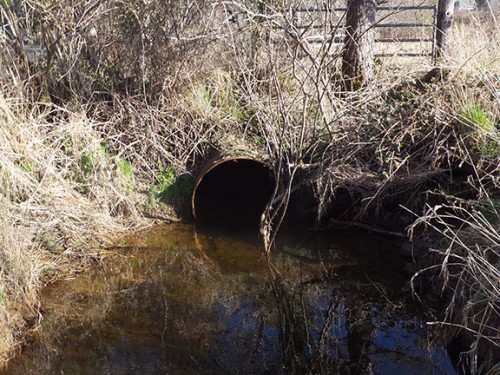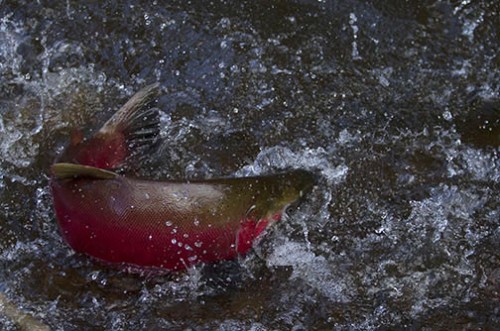Our story starts here, in the Neawanna Estuary. (The whole story starts hundreds or thousands of miles away, probably in the far Northeast Pacific, when coho salmon that hatched from eggs deposited in Thompson Creek two and a half years earlier turn toward home.) Guided by forces (magnetism? smell?) we humans barely understand or perhaps entirely misunderstand (“I don’t think we know much about salmon in the context of their whole life cycle,” says naturalist and photographer Neal Maine, who has been observing and reading about the fish his entire life), scores of individual coho find their way back to the mouth of the Necanicum River at Seaside, Oregon, in late fall and early winter. There they wait until the conditions are right to navigate the final two miles to their spawning grounds. They enter the river, hang a left into Neawanna Creek, then make a second left into Mill Creek where it flows under US 101.
That’s when it gets interesting, as documented in these photos of Neal’s.
A tide gate at the entrance to Mill Creek used to block returning coho salmon, although a few fish would squeeze past during extremely high water, Neal says. You can still see hinges on either side of the culverts the fish must swim through, but the gates themselves were removed in the 1990s.
Mill Creek curves around the south end of the runway at the Seaside Airport. The creek continues to the east, but the coho bound for Thompson and a few other creeks bear south, toward Stanley Lake.
Some of them continue into Stanley Lake, heading toward three spawning streams that feed the lake. But the Thompson Creek coho take a sharp left just before reaching the bridge at Lewis and Clark Road. Thompson Creek is just a sliver of a stream here; look carefully at the middle of the photo above to see the confluence of Thompson and Mill creeks.
Then the fish continue up what amounts to a ditch running alongside Lewis and Clark Road: straight, channelized, with lawn in place of native riparian vegetation along the stream border. Culverts carry the water (and fish) under the road at Boehm Acres …
… and under four more driveways.
Where Lewis and Clark Road swings left and starts to ascend, Thomspon Creek turns sharply right and ducks under the road (another culvert). These are not—as you can see—modern “salmon-safe” culverts designed to mimic nature but straightforward, old-style corrugated metal tubes designed to facilitate water passage. Yet somehow, Neal notes, it works.
The Thompson Creek coho have one more culvert to go through, under the side street next to the Thompson Falls Estates pump house off Nygaard Road.
Here they used to skirt a beaver dam, but that dam failed in fall 2013. Those beavers moved across the street to Ditch Creek; above you can see volunteers with NCLC planting willow stakes in January to invite beavers back. It is part of the on-going habitat restoration work NCLC has been doing at its 80-acre Thompson Creek and Stanley Marsh habitat reserve since 2006.
Fish that have reached this point now have only a short distance to travel to reach their goal:
a scant quarter-mile of gravel streambed ending at the base of Thompson Falls.
“Yes, there are culverts there, but with 300 fish coming up, do we need to get excited about the culverts?” Neal says. “We use ecological observation to help guide next steps. Here, it’s working, so whatever it is, maintain that level of habitat. It’s not about the culverts; what’s actually happening is what it’s about.”
Removing the tide gate and enhancing stream conditions has helped revive the Thompson Creek coho run. It is now among the most robust runs on the Oregon Coast.
“It’s a celebration of the capacities of the fish: look how altered the system is, and they’re still doing their thing!” Neal says. “But at the end of the day, without spawning habitat, there’s no point. Unlike the beaver—which creates the habitat, which makes the ecosystem—salmon depend on habitat that’s in place. Salmon have a lot of survival skills, but they can’t compensate for poor habitat. Spawning gravel is the goal.
“Maintain habitat, and they will come.”











Comments